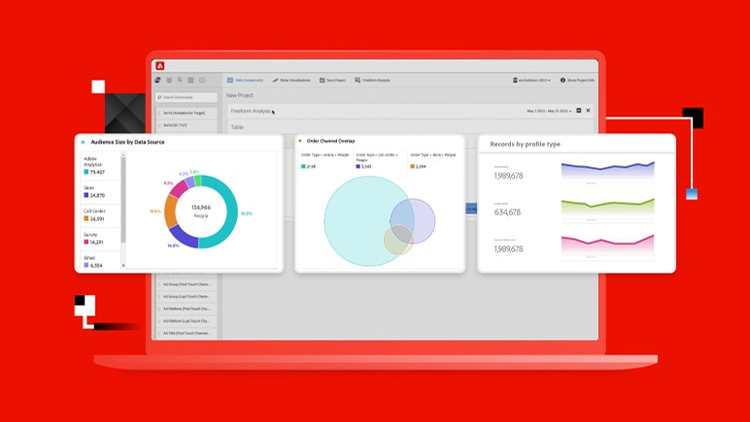Introduction
In today’s fast-moving digital economy, it’s easy to get overwhelmed by enterprise tools promising real-time personalization, data unification, and seamless customer experiences.
Adobe offers several powerful platforms in this space, including Adobe Experience Platform (AEP), Adobe Experience Manager (AEM), and its real-time Customer Data Platform (CDP). While these solutions are part of the same ecosystem, they serve very different purposes.
This guide is designed to clearly explain what each one does, how they relate, and when to choose one over the other.
Adobe Experience Platform (AEP) explained
Adobe experience platform acts as the data foundation of the Adobe Experience Cloud. It ingests, unifies, and standardizes customer data across channels in real time, building accurate and actionable customer profiles. These profiles power smarter decision-making and real-time personalization across channels.
Core Capabilities:
- Unifies structured and unstructured customer data
- Creates real-time customer profiles
- Supports identity resolution across devices
- Enables AI-driven insights using Adobe Sensei
- Governs data usage and consent preferences
Think of AEP as the digital nervous system that collects, connects, and activates data across the entire customer journey.
Real-world example:
Verizon uses AEP to unify data from mobile apps, stores, and support centers, creating a single real-time profile for each customer. This enables dynamic personalization in both digital and offline channels.
Adobe Experience Manager (AEM) explained
Adobe experience manager is Adobe’s enterprise content management system. It allows teams to create, manage, and deliver content for websites, mobile apps, and digital forms, all while supporting collaboration across global teams.
Core Capabilities:
- Manage websites, mobile apps, and forms
- Organize and tag assets through a centralized digital asset manager (DAM)
- Personalize content using behavioral and profile data
- Support multilingual and region-specific content
- Integrate with other Adobe tools like Target and Analytics
AEM is your digital experience engine, where content gets created, optimized, and delivered.
Real-world example:
Philips Healthcare uses AEM to manage its multilingual websites and product catalogs, delivering personalized and region-specific content to healthcare professionals worldwide.
What is a Customer Data Platform (CDP)?
A customer data platform collects, unifies, and activates first-party customer data. It allows marketing and customer experience teams to create targeted segments and activate them across channels like advertising, email, and web personalization.
Adobe’s real-time CDP is built directly on AEP. While AEP is the backend foundation, the CDP is a more user-friendly, marketer-facing interface for audience activation.
Core Capabilities:
- Collect data from digital and offline channels
- Create unified customer profiles
- Segment users dynamically
- Activate audiences across email, web, ads, and apps
- Support consent and data privacy preferences
CDPs are the go-to tool for marketing teams that want to quickly act on data, without relying heavily on IT.
Real-world example:
T-Mobile uses Adobe’s real-time CDP to trigger personalized campaigns across SMS, email, and digital ads. Segments update in real time based on user behavior, such as app usage or store visits.
Side-by-side comparison
Here’s how AEP, AEM, and CDPs differ at a glance:
| Feature | Adobe Experience Platform (AEP) | Adobe Experience Manager (AEM) | Customer Data Platform (CDP) |
| Primary Role | Unify and activate customer data | Manage and deliver digital content | Segment and activate audiences |
| Real-time Data Personalization | YES | NO (Unless integration) | YES |
| Personalization | Powers other tools | Content-based targeting | Data-based targeting |
| Machine Learning | YES (Adobe Sense) | Limited | Varies by vendor |
| Best for | Data architects, CX strategists | Marketing and content teams | Digital marketing teams |
| Integration Depth | Deep with Adobe cloud | Deep with Adobe cloud | Depends on vendor |
Choosing the right solution
If you’re unsure which Adobe product to prioritize, start by clarifying your use case:
- Choose AEP if your organization struggles with siloed data, and you need a real-time foundation to personalize customer journeys across channels.
- Choose AEM if your focus is scaling high-quality digital content and streamlining website and asset management.
- Choose CDP if your marketing team wants to act on unified data quickly to run campaigns, improve targeting, and personalize experiences.
Many enterprise brands integrate all three tools. AEP builds the foundation, the CDP activates segments, and AEM delivers the content that creates impact.
Conclusion
While Adobe experience platform, experience manager, and customer data platforms all contribute to modern customer experience strategies, each solves a very different problem.
AEP builds the data brain of your business. AEM brings that intelligence to life through personalized content. CDPs enable your marketing team to act on unified data in real time.
If your organization is navigating how to align data, content, and personalization, our experts at AEM Analytics are here to help. We provide hands-on strategy and implementation support tailored to Adobe’s experience cloud stack.
Need guidance on which Adobe tools fit your roadmap?
Talk to our Adobe experience specialists for a free consultation.

